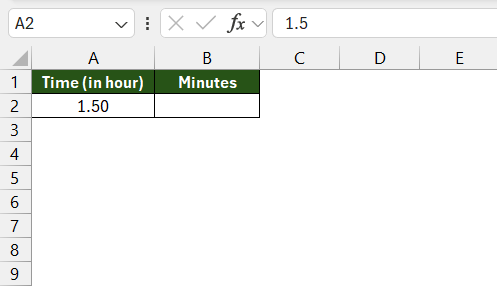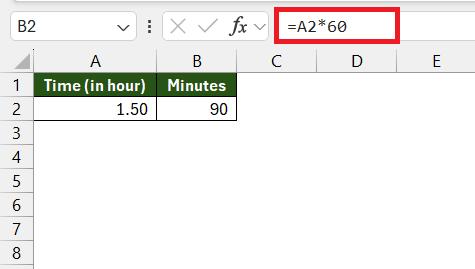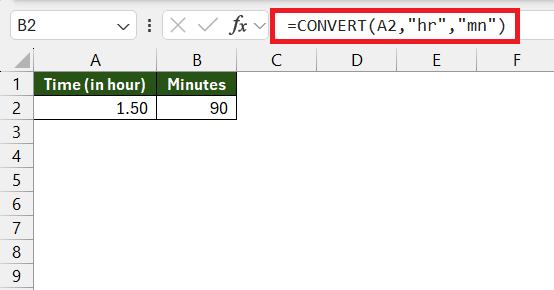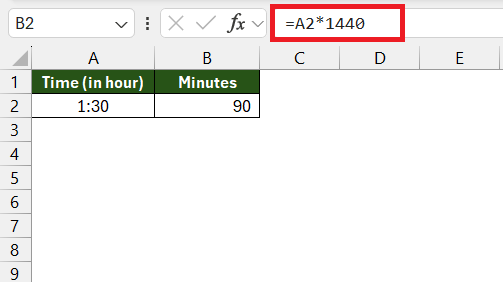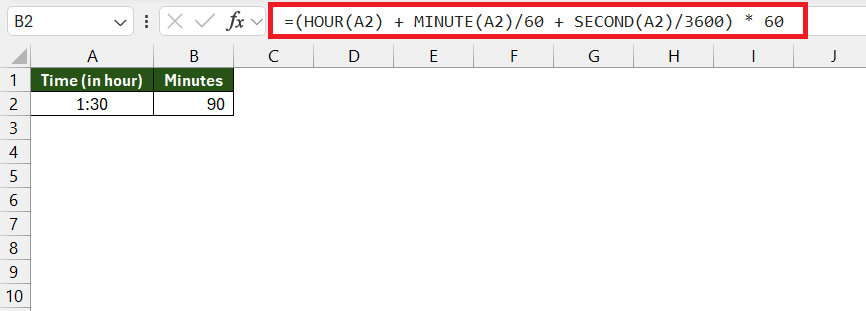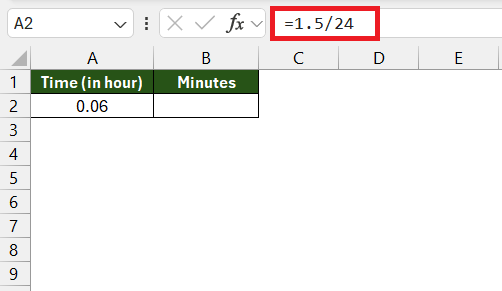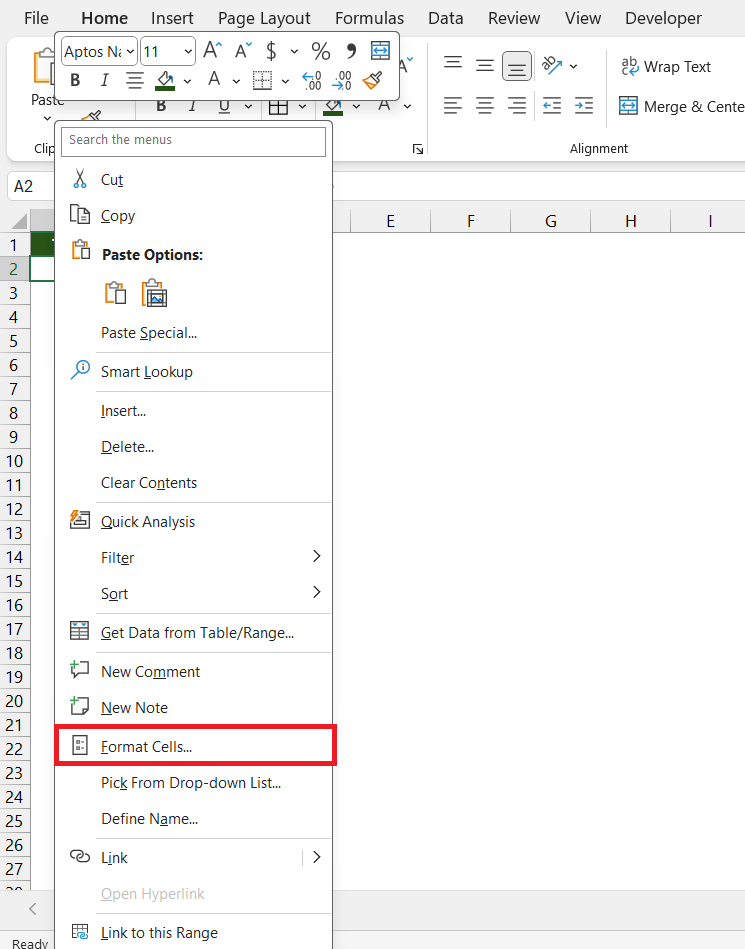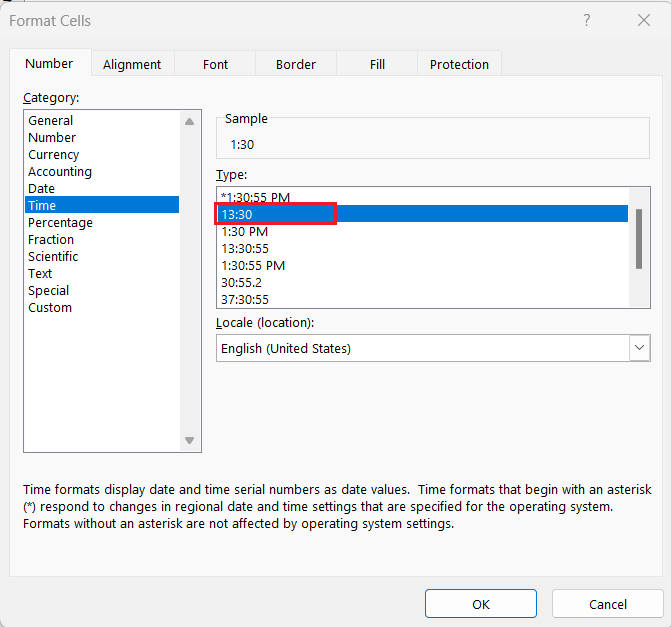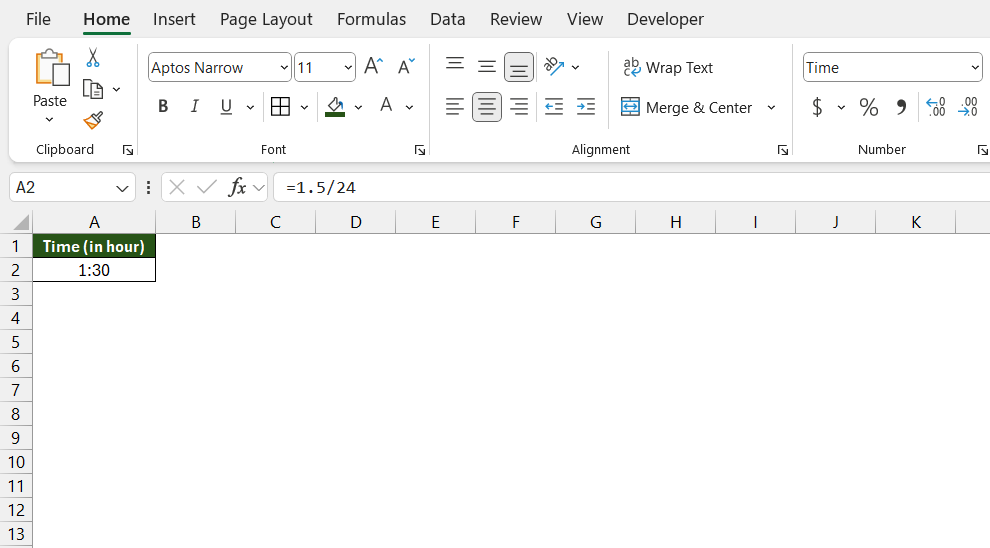In many scenarios, particularly when managing time-tracking or project scheduling, converting time measurements from hours to minutes becomes crucial for accuracy and ease of calculations. Microsoft Excel offers versatile functions that can turn this task into a simple operation. Let’s explore the straightforward process of converting 1.5 hours to minutes in Excel, ensuring that your time data is precise and universally interpretable.
Key Takeaways
- To convert hours and minutes to minutes in Excel, use the format =HOUR(cell)*60+MINUTE(cell).
- Change the cell format to Number before entering the formula.
- Utilize Excel’s Fill Handle feature to copy the formula to other cells quickly.
- Apply the =CONVERT(cell,”mn”,”hr”) function for converting minutes back to hours in Excel.
Download the spreadsheet and follow along with the tutorial on How to convert 1.5 hours to minutes in Excel – Download excel workbook1.5-hours-to-minutes.xlsx
Table of Contents
Introduction: Mastering Time in Excel
The Importance of Time Conversion in Data Analysis
Time is an essential dimension in data analysis, providing insights into trends, performance, and efficiency across various industries. In Excel, converting time data into different units can help analysts create more powerful and precise reports. Furthermore, this conversion is critical in payroll calculations, scheduling, resource planning, and other time-sensitive analyses where accuracy is paramount.
Understanding Excel’s Capabilities for Time Management
Excel is a potent tool for managing and manipulating time-related data, accommodating a broad spectrum of functions that can handle everything from the simplest to the most complex time-related tasks. It recognizes time as a part of a day, allowing for minute adjustments, calculations over multiple days, and even the accounting of anomalies such as leap years when working with dates.
Making the most of Excel’s capabilities for time management involves understanding how the software interprets and stores time. The program assigns a fractional value to time, where one whole number represents a full day, and decimals represent fractions of that day. For instance, in Excel’s system, 1.5 hours would be stored as 1.5/24 or 0.0625 because there are 24 hours in a day.
Whether you’re dealing with the AM/PM format, 24-hour time, or durations that exceed 24 hours, Excel can adapt and display time data correctly. By leveraging formats, formulas, and functions, users can perform tasks such as adding and subtracting time, converting units of time, and calculating the difference between two timestamps with ease and precision.
Understanding and using Excel’s time management capabilities can result in significant productivity gains and ensure that time data is an asset, not an obstacle, in your data management tasks.
Getting Started with Time Conversions
Breaking Down the Basics of Excel Time Format
Understanding Excel’s time format is critical for anyone looking to work effectively with time-related data in Excel. As mentioned earlier, Excel stores times as a fractional part of a day, with the value 1 representing a full 24-hour period. This means that:
1 houris represented as1/24or approximately0.04166671 minuteis1/(24*60)or approximately0.0006944441 secondis1/(24*60*60)or approximately0.0000115741
Given this system, Excel can display time in a variety of formats. The default format is hh:mm:ss, where hh stands for hours, mm for minutes, and ss for seconds. If you need to accommodate durations that exceed 24 hours, the format [hh]:mm:ss is used, with square brackets around the hh to display cumulative hours beyond the 24-hour threshold.
The Step-by-Step Guide to Convert 1.5 Hours to Minutes
Using Simple Multiplication to Transform 1.5 Hours to Minutes
STEP 1: Enter the time value in a cell.
STEP 2: Since there are 60 minutes in an hour, you can use direct multiplication to convert 1.5 hours to minutes.
=A2*60
This quick multiplication method is efficient for converting fixed time durations, like 1.5 hours to minutes in Excel with just a simple formula.
Applying Convert Functions to Automate Conversions
Excel’s repertoire of built-in functions makes it easy to automate time conversions, reducing the chance for human error and increasing efficiency. Here, we’ll focus on how you can apply specific Excel functions to convert time, such as 1.5 hours, to minutes.
The CONVERT function in Excel is designed to change a number from one unit to another, including time units.
Formula Example: =CONVERT(A2, “hr”, “mn”)
In this formula, A2 is the cell that contains the time in hours that you want to convert to minutes, "hr" stands for hours, and "mn" represents minutes. This will easily convert 1.5 hours to minutes.
Convert Time in hh:mm format to Minutes
Simple Multiplication
Type in the formula =A2 * 1440 in cell B2 to display hours in minutes. Why 1440? Because there are 1440 minutes in a day (24 hours × 60 minutes).
Using HOUR, MINUTE, and SECOND Functions
When you need a more detailed breakdown of time or are working with time formats, you can use the HOUR, MINUTE, and SECOND functions for conversion and display purposes.
Formula Example: =(HOUR(A2) + MINUTE(A2)/60 + SECOND(A2)/3600) * 60
In this example, A2 contains the actual time stamp, and the formula breaks the time into its components before converting it to minutes.
Regardless of the function or feature you choose, Excel’s utility in automating the time conversion processes is in its ability to accurately and effectively handle large datasets, executing these conversions with a high degree of reliability, and reducing the time it would otherwise take to manually calculate each conversion.
Apply Custom Formatting
Follow the steps below to change time in decimal format to time in hh:mm format:
STEP 1: Divide the time by 24 to convert the time from decimal format to HH:MM format.
STEP 2: Right-click the cell and select Format Cells.
STEP 3: In the dialog box, select Time from the Category list. Choose the desired time format (hh:mm) from the Type list.
And, Voila. The time format has changed.
Remember, proper formatting of time data ensures clarity and prevents misinterpretations, which is crucial for accurate data analysis and reporting.
Tips and Tricks for Accurate Time Calculations
Time conversion in Excel can sometimes trip up even experienced users. To ensure accuracy, you should be aware of some common pitfalls and know how to avoid them:
Miscalculating Time Across Midnight: When calculating the difference between two times that cross midnight, you may encounter negative values if not handled properly. Always make sure to account for the day change, either by including date and time in your calculations or by using a formula that correctly handles such instances.
Incorrect Time Format: Using the wrong time format can result in errors or misleading representations of time. Double-check that you’ve selected the appropriate time format for your data, and be mindful of the differences between formats such as hh:mm, hh:mm:ss, and [hh].
Not Accounting for Leap Years: When performing date calculations that span multiple years, remember to account for leap years. Excel functions like DATE can accommodate this automatically, but custom calculations may need to include this consideration.
Exceeding 24 Hours without Custom Formatting: When adding times that result in more than 24 hours, ensure the cell is formatted to display the cumulative hours correctly with the [h]:mm:ss or [h]:mm format.
Failing to Use Absolute References in Formulas: When copying formulas that involve fixed values (like 60 for the number of minutes in an hour), be sure to use absolute references (e.g., $A$1) to prevent incorrect cell references when auto-filling.
Losing Precision with Rounded Values: When converting time, ensure that the displayed precision reflects the needed accuracy. If seconds are important, use a format that includes seconds; otherwise, valuable data might be rounded off and lost.
Ignoring AM/PM Notations: For the 12-hour clock, it’s crucial to consider AM/PM notations; otherwise, your calculations could be 12 hours off. The 24-hour clock format avoids this issue.
By staying mindful of these pitfalls and applying due diligence when formatting and performing time calculations, you can ensure that your time conversion processes in Excel remain accurate and reliable.
FAQ: Excelling at Excel Time Conversions
What are the Foolproof Methods to Convert Hours to Minutes in Excel?
The foolproof method to convert hours to minutes in Excel is by using arithmetic calculations with the HOUR and MINUTE functions. To achieve this, you simply multiply the hour value by 60 and add the minute value, with the formula: `=HOUR(cell)*60 + MINUTE(cell)`, where “cell” refers to the cell containing the time value. This will give you the total time in minutes.
How Can I Handle Time Values Over 24 Hours?
To handle time values over 24 hours in Excel, apply a custom time format that includes square brackets around the time unit code, such as `[h]:mm:ss` for hours, minutes, and seconds. Select the target cells, press `Ctrl + 1` to open the Format Cells dialog box, choose the Custom category, and enter your desired time format code to accurately display the total hours, minutes, or seconds exceeding the standard time units.
How do I convert 1.5 hours to minutes in Excel?
To convert 1.5 hours to minutes in Excel, you can use the CONVERT function. Simply type the formula `=CONVERT(1.5,”hr”,”mn”)` into a cell, and press the ENTER key. Excel will then calculate the value and display 90 minutes as the result.
How do I add 1.5 hours to a time in Excel?
To add 1.5 hours to a time in Excel, first type the starting time into a cell. Then, in the adjacent cell, type in the formula to add 1.5 hours, such as `=A1+”1:30″` (if A1 is the cell with the starting time), and press Enter. The result will be the starting time increased by 1 hour and 30 minutes since 1.5 hours is equivalent to 1 hour and 30 minutes
John Michaloudis is a former accountant and finance analyst at General Electric, a Microsoft MVP since 2020, an Amazon #1 bestselling author of 4 Microsoft Excel books and teacher of Microsoft Excel & Office over at his flagship MyExcelOnline Academy Online Course.

